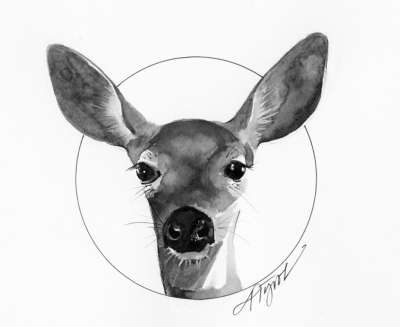
One of the evolutionary adjustments whitetail deer have made is to reproduce early and often. A six-year-old whitetail doe can easily become a great-great-grandmother, and she can continue to produce fawns each year until she is ten years old.
Most deer in New Hampshire and Vermont are born in early summer, and they reach sexual maturity when they are little more than a year old. Young bucks start growing their first set of antlers in the summer; young does will be entering their first estrus in November. Female deer can be even more precocious, reaching sexual maturity at six months of age if they live in good habitat. Sexual maturation of both sexes is largely dependent on body size, which in turn depends on habitat quality and age.
Because we live in an area with severe winters, a short, precisely-timed breeding season is key to fawn survival. A doe’s gestation period is 200 days – if she gives birth too early, a fawn will be exposed to freezing temperatures and the doe may not have sufficient greenery with which to stimulate her milk; if she gives birth too late, the fawn may not be robust enough to survive its first winter.
To address this, deer have a built in breeding alarm clock that’s set by the amount of light in a day. In autumn, the pituitary gland is stimulated into reproductive function by the gradual shortening of the length of time it is exposed to light relayed by the optic nerves. The pituitary regulates the hormones responsible for the bucks’ sperm production and the does’ ovulation. The three important hormones are follicle stimulating hormone (FSH), luteinizing hormones (LH), and prolactin or lactogenic hormone (LTH). In bucks, these hormones act together to initiate the production of testosterone, which along with FSH, enables the manufacture of sperm cells. Testosterone also influences antler development, body strength, and aggressive behavior.
In does, these hormones promote follicle development in the ovaries and the production of estrogen. Estrogen is responsible for increased development of the female sex organs and for the behavioral changes that permit a single buck to court her. Estrogen also prepares the uterus to receive the mature eggs that will soon rupture from the ovaries.
All of this hormonal action comes to fruition around the end of October, when the first does will come into heat. The peak of conception typically occurs the third week of November, followed by very diminished breeding activity into early December. For only 24 hours, the doe will be receptive to the buck’s courting. Over the course of the following three weeks, almost every doe in the twin states will go into estrus, and, amazingly enough, considering the brief window of opportunity, the great majority of them (over 90 percent) will be bred. Does will give birth the following spring, usually to twins.
Occasionally, conception will not occur, usually because the doe was young or the buck did not have viable sperm. When this happens, the doe will go through her pre-estrus cycle again and become fecund in approximately 28 days. If conception doesn’t occur until late December, fawns will not be born until mid-July. This late birthing limits the amount of time for the newborns to grow before the onset of winter and puts them at a distinct disadvantage for survival.
It has happened that a doe will not get bred until a third heat cycle, which means that fawns will be born in August. A fawn born in June can reach 100 pounds by winter; one born in August will have a hard time reaching 50. Still sporting their spots in October as they try to develop their winter coats, the deck is stacked heavily against these late fawns.
The November rifle season for deer in Vermont and New Hampshire is timed to coincide with the primary estrus period for two reasons. First, the young of the year have grown enough to be able to take care of themselves without their mothers’ care. Second, it takes advantage of the buck’s preoccupation with reproduction. Deer are very wary and difficult to hunt. If it weren’t for momentary lapses in defense, hunter success would be a small fraction of the roughly 10 percent in a typical year. This would render hunting useless as a deer herd management tool. The resulting over-population of deer and its devastating effect on the regeneration of the forest would prove to be a huge problem.


Discussion *